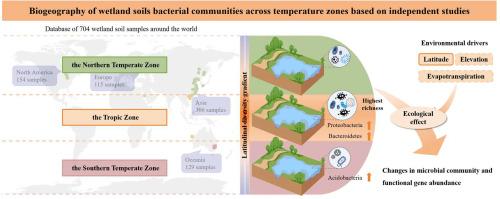基于独立研究的跨温区湿地土壤细菌群落的生物地理学和多样性
IF 6.3
2区 环境科学与生态学
Q1 ENVIRONMENTAL SCIENCES
引用次数: 0
摘要
湿地是重要的生态系统,具有调节气候、净化环境、物质循环和能量流动等重要功能。它们在主要由微生物驱动的全球生物地球化学循环中发挥着重要作用。了解湿地微生物在不同温带的分布是理解其生态作用的关键。采用方差分析、主成分分析、非度量多维尺度和结构方程模型等统计方法,对704个湿地土壤样品的微生物群落进行meta分析,考察不同温度区域的生物地理特征和多样性。结果表明,热带地区微生物丰度最高,南温带最低,具有明显的纬度多样性梯度格局,与其他温区差异显著。变形菌门(37.76% ~ 51.04%)、酸杆菌门(5.11% ~ 30.70%)和拟杆菌门(3.43% ~ 16.16%)占主导地位。值得注意的是,南温带地区差异显著,酸杆菌感染率较高(30.07%)。为了研究这种差异的原因,我们筛选了177个核心微生物组,并确定纬度是影响微生物群落组成的核心环境因子。此外,土壤微生物表现出较强的氮循环潜力(特别是nirD和nirB)和碳循环潜力(特别是accA),基因丰度在不同温度区域变化不大。湿地细菌群落也表现出较高的稳定性,平均变异度指数在0.1 ~ 0.3之间。本研究结果提高了对湿地细菌群落多样性和生物地理机制的认识,对湿地的管理和保护具有重要意义。本文章由计算机程序翻译,如有差异,请以英文原文为准。

Biogeography and diversity of wetland soils bacterial communities across temperature zones based on independent studies
Wetlands are vital ecosystems that perform essential functions such as climate regulation, environmental purification, material circulation and energy flow. They play an essential role in global biogeochemical cycles, driven primarily by microorganisms. Understanding the distribution of wetland microorganisms across different temperature zones is key to comprehending their ecological roles. A meta-analysis of 704 wetland soil samples on microbial communities was conducted, using statistical methods like analysis of variance, principal component analysis, non-metric nultidimensional scaling, and structural equation modeling to examine biogeography and diversity across temperature zones. Our findings revealed a clear latitudinal diversity gradient pattern, with the highest microbial abundance in the tropics and the lowest in the southern temperate zone, which differed significantly from other temperature zones. Proteobacteria (37.76 %-51.04 %), Acidobacteria (5.11 %-30.70 %) and Bacteroidetes (3.43 %-16.16 %) dominanted the bacterial communities. Notably, the southern temperate zone showed significant variations, with a higher prevalence of Acidobacteria (30.07 %). To investigate the causes of this variability, we screened 177 core microbiome and identified latitude as the core environmental factor influencing microbial community composition. Moreover, soil microorganisms exhibited strong nitrogen cycling potentials (particularly nirD and nirB) and carbon cycling potentials (especially accA), with gene abundances showing little variation across temperature zones. Wetland bacterial communities also demonstrated high stability, with average variation degree index values ranging from 0.1 to 0.3. Our results improve the understanding of the diversity and biogeographic mechanisms of wetland bacterial communities and hold significant implications for the management and conservation of wetlands.
求助全文
通过发布文献求助,成功后即可免费获取论文全文。
去求助
来源期刊

Journal of Environmental Sciences-china
环境科学-环境科学
CiteScore
13.70
自引率
0.00%
发文量
6354
审稿时长
2.6 months
期刊介绍:
The Journal of Environmental Sciences is an international journal started in 1989. The journal is devoted to publish original, peer-reviewed research papers on main aspects of environmental sciences, such as environmental chemistry, environmental biology, ecology, geosciences and environmental physics. Appropriate subjects include basic and applied research on atmospheric, terrestrial and aquatic environments, pollution control and abatement technology, conservation of natural resources, environmental health and toxicology. Announcements of international environmental science meetings and other recent information are also included.
 求助内容:
求助内容: 应助结果提醒方式:
应助结果提醒方式:


